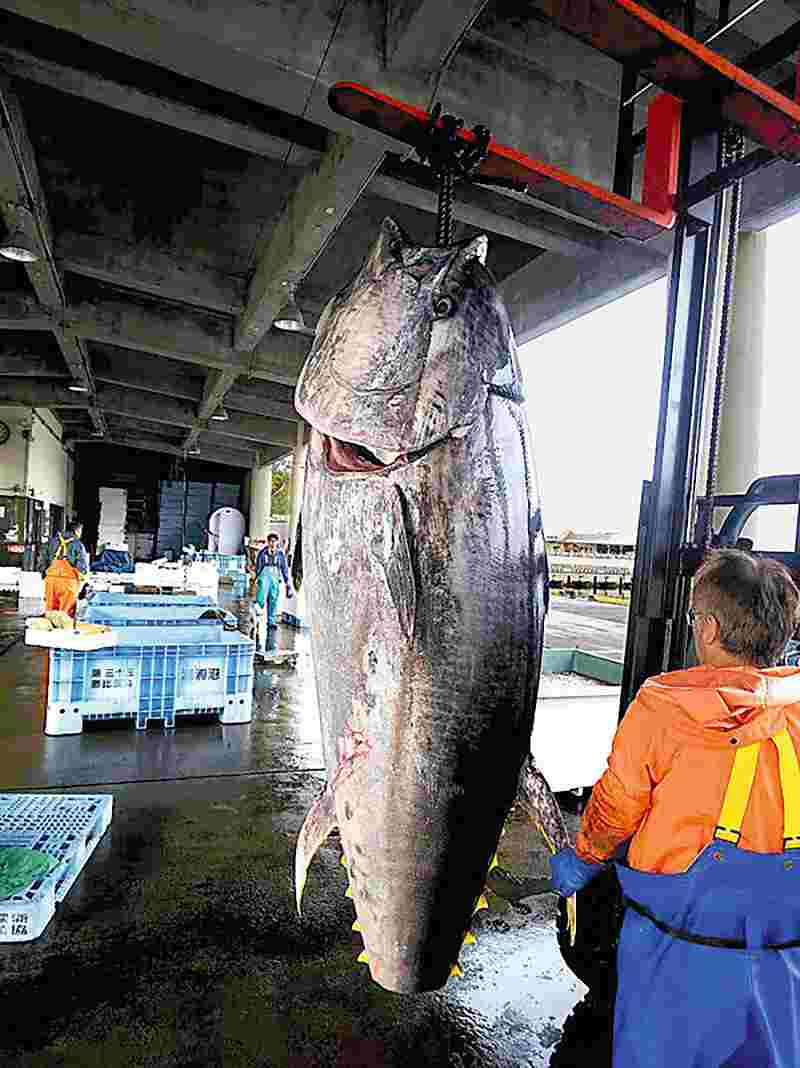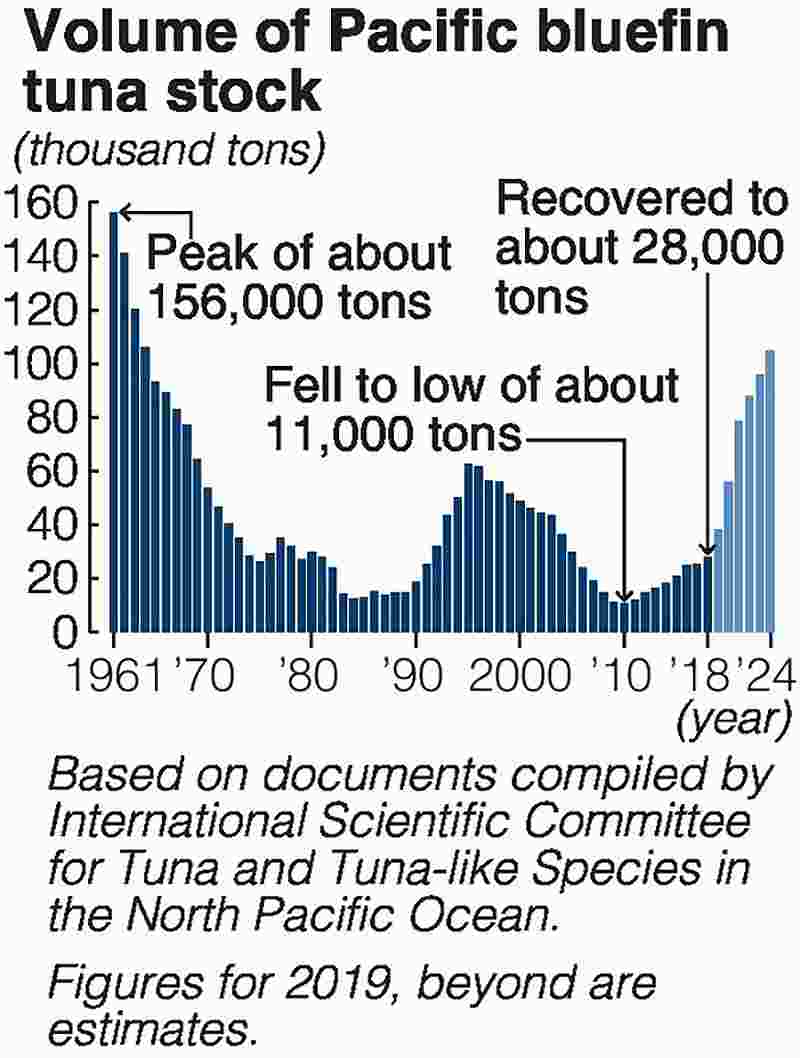
A bluefin tuna weighing about 300 kilograms is unloaded at the port of Fukaura, Aomori Prefecture, in October.
11:18 JST, December 24, 2021
Fishing quotas for bluefin tuna, a fish prized as an ingredient for high-end sushi, will increase next year after an international body approved the move following a rebound in tuna stocks thanks to the cooperative efforts of fishermen and other industry players.
However, bluefin tuna previously was designated as an endangered species due to overfishing, so the Fisheries Agency will strengthen management of this resource.
The decision to increase the quota cheered Takao Iwane, a 73-year-old fisherman who has plied the Sea of Japan waters off the town of Fukaura, Aomori Prefecture, for about 40 years.
“Bluefin tuna prices go up in winter, so the announcement encouraged me,” said Iwane, who catches tuna using a handheld line with a single hook.
Fukaura is known as one of the rock stars of Japan’s tuna fishing industry. Fishermen could operate without restrictions in waters off Fukaura several decades ago, but catches plunged around the time after regulations were introduced in 2015. In 2021, the four fishery cooperatives in Fukaura were allocated a combined quota of 302 tons. The cooperative of which Iwane is a member allowed each fisherman using the single hook method to catch just one ton of bluefin tuna. Iwane decided not to go fishing this summer, opting instead to retain his precious quota until winter, when tuna trading fetches higher prices. The cooperatives took other steps, such as requiring the release of tuna that become trapped in fixed fishing nets.
Poor weather also prevented fishermen from leaving port on some days. Many in the industry fell on hard times.
Iwane believes the number of tuna in the sea off Fukaura has been gradually increasing in recent years.
“I think the decrease in this resource has already hit rock bottom,” Iwane said. “If I couldn’t catch fish because my skills have deteriorated, I wouldn’t complain, but it’s disappointing that the current quota is so low. I hope tuna numbers continue to rebound and quotas will be increased.”
Stock management
According to the Fisheries Agency, stock of bluefin tuna with breeding capability in the Pacific Ocean peaked at about 156,000 tons in 1961, but plummeted to about 11,000 tons in 2010. Bluefin tuna was once even designated as an endangered species, partly due to overfishing by Japanese fishing boats.
The Western and Central Pacific Fisheries Commission (WCPFC), an organization formed by the governments of nations and territories in the region, set out to protect and conserve tuna stocks, and introduced catch limits in 2015.

The stock volume had recovered to about 28,000 tons in 2018, so the WCPFC decided at its latest meeting to boost — for the first time — quotas by 15% for large fish weighing at least 30 kilograms. Japan’s quota for 2022 was set at 5,614 tons, an increase of 732 tons from the 2021 quota of 4,882 tons.
Following the move, the Fisheries Agency decided Tuesday on how this quota would be allocated among fishermen in Japan. Coastal fisheries in most prefectures are likely to be given larger quotas than they received in 2021.
Efforts bearing fruit
The expansion in catch quotas is the result of cooperation among many players in the fishing industry.
Since 2018, the agency set upper limits for the offshore fishing industry managed by the central government and coastal fishery operators in each prefecture. Prefectural governments and other authorities were able to order operators who exceeded their quota to stop fishing. Operators who failed to follow this order could, under the revised Fisheries Law, be imprisoned for up to three years or fined up to ¥3 million.
The agency also introduced a system under which the volume by which a quota was exceeded would be subtracted from the quota for the next fishing season. Between July 2017 and June 2018, Hokkaido fishermen landed 769.5 tons of bluefin tuna, greatly eclipsing the prefecture’s entire quota of 111.8 tons. This was because some operators caught far more fish than allowed, but the agency later decided to effectively set the prefecture’s quota for bluefin tuna the following year at zero.
“The recovery in tuna stock is the culmination of huge sacrifices made by fishermen and serious efforts such as releasing fish that had been caught in nets,” said Miwako Takase, an official at the agency who participated in negotiations at the WCPFC.
The agency will begin even stricter resource management steps from January. The agency will introduce a system under which quotas for large fish caught offshore will be allotted to individual boats, and any violation of these rules will be subject to immediate penalties.
“Collecting and scientifically analyzing fishing catch volume data will enable fairer management of this resource,” a senior agency official said.
Prices at restaurants could fall
An estimated 30,000 tons of bluefin tuna, including cultivated fish, is supplied to Japan annually. The latest quota expansion equates to about 2% of this volume. Some observers expect the increase in supply could lead to cheaper prices.
About 80% of customers at Taiko Chaya, a seafood restaurant in Chuo Ward, Tokyo, that regularly holds in-store tuna-cutting shows, order the signature dish featuring generous servings of various tuna cuts, including top-quality tuna with high fat content. The dish currently costs ¥1,848, including tax, but about 30 years ago, the price was around 40% lower because bluefin tuna was cheaper to purchase.
Mitsuru Saga, who operates the restaurant, welcomed the larger tuna quota.
“Bluefin tuna is the tastiest of all tuna,” said Saga, 73. “I expect prices could come down if the volume of fish available increases. I hope many people will enjoy eating this tuna.”
"Business" POPULAR ARTICLE
-

Keidanren Chairman Yoshinobu Tsutsui Visits Kashiwazaki-Kariwa Nuclear Power Plant; Inspects New Emergency Safety System
-

Tokyo Economic Security Forum to Hold Inaugural Meeting Amid Tense Global Environment
-

Imports of Rare Earths from China Facing Delays, May Be Caused by Deterioration of Japan-China Relations
-

University of Tokyo Professor Discusses Japanese Economic Security in Interview Ahead of Forum
-

Japan Pulls out of Vietnam Nuclear Project, Complicating Hanoi’s Power Plans
JN ACCESS RANKING
-

Keidanren Chairman Yoshinobu Tsutsui Visits Kashiwazaki-Kariwa Nuclear Power Plant; Inspects New Emergency Safety System
-

Tokyo Economic Security Forum to Hold Inaugural Meeting Amid Tense Global Environment
-

Imports of Rare Earths from China Facing Delays, May Be Caused by Deterioration of Japan-China Relations
-

University of Tokyo Professor Discusses Japanese Economic Security in Interview Ahead of Forum
-

Japan Pulls out of Vietnam Nuclear Project, Complicating Hanoi’s Power Plans

























